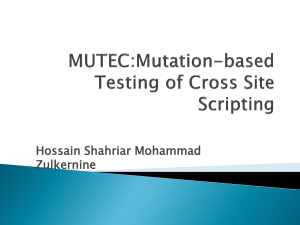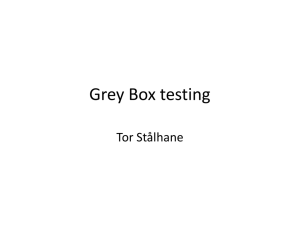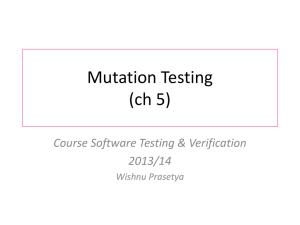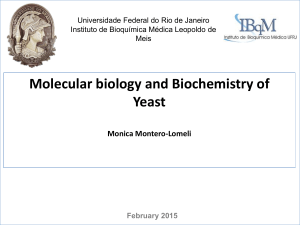An Effective Path Selection Strategy for Mutation Testing
advertisement
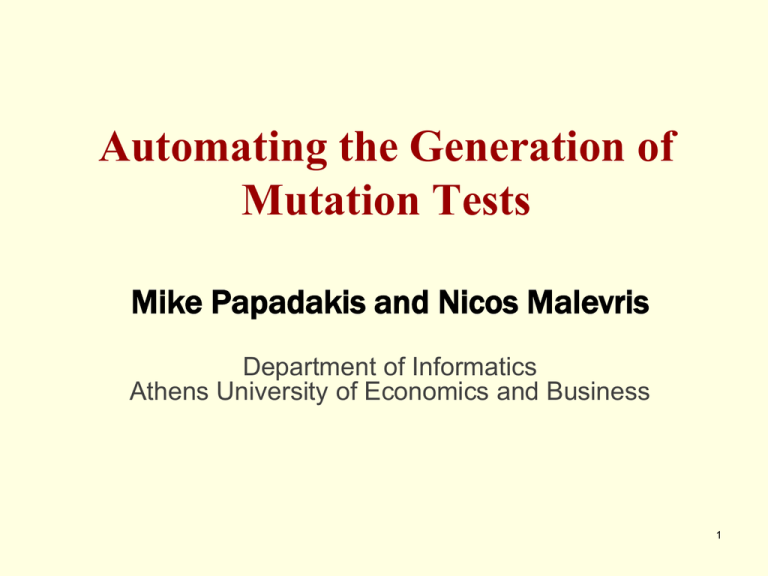
Automating the Generation of Mutation Tests Mike Papadakis and Nicos Malevris Department of Informatics Athens University of Economics and Business 1 Test Data Generation Approaches Symbolic execution Select set of paths Produce a system of algebraic constraints Solve and generate test cases Challenges (Symbolic execution) Infeasible paths Complex-unhandled expressions Availability of source code 2 Test Data Generation Approaches Search based approaches Definition of program input Dynamic program execution Fitness function o (efficiency and effectiveness) Challenges Handling of dynamic program inputs Require a high number of executions Handling of specific cases (e.g. flag problem) Effective fitness function 3 Test Data Generation Approaches Dynamic Symbolic Execution Simultaneously perform actual and symbolic execution o Simplify the process based on concrete program execution Produce a system of algebraic constraints Solve and generate test cases Challenges Infeasible paths Scalability issues 4 Killing Mutants In order to kill a mutant, tests must Stage 1: Reach the mutant Stage 2: infect the program state Stage 3: propagate the infected state 5 Killing Mutants Reach the mutant (Reachability condition) Infect program state (necessity condition) Program execution must cause a discrepancy in the program state E.g. Orig: a > b, Mut = a ≥ b → a > b ≠ a ≥ b o a == b where Orig = false, Mut = true Propagate (sufficiency condition) Heuristic approaches o explore path space, measure of mutant’s impact Joint satisfaction (Reach && Infect && Propagate) 6 Killing Mutants (path selection) Symbolic Execution Reach o Use paths from program input to mutant Infect o Use necessity constraints to infect program state o Original Statement ≠ Mutated Statement Propagate o Explore the path space (from mutant to program output) Path selection Strategy 7 Killing Mutants (path selection) Enhanced Test Model (Enhanced Control Flow Graph) Represent mutants in the model Guide the selection of paths and the produced constraints based on the Shortest path strategy 8 Killing Mutants (path selection) Shortest Path Strategy, the k-value An efficient path selection strategy. (eliminates the effects of infeasible paths) Select shortest paths from program input (S) to the mutant statement (m) (S , x) xm (k ) m (k ) Heuristic approach to weak mutation Strong mutation can be tackled incrementally (k ) m (S , x) xm mx ( x, F ) (r ) (t ) 9 Killing Mutants Dynamic approaches Dynamic approaches Gain the required information from actual program execution Require high number of program execution Mutation Testing Need to unify the runtime information of the original and mutant programs Need to include mutant neccesity and sufficiency conditions into program structure Need for efficiency (high cost) 10 Mutant Schemata Mutant schemata-Parameterized mutants Technique for efficiently producing mutants Embeds all mutants into one meta-mutant program Use of global parameter to specify the mutants Example original meta-mutant a > b + c → RelationalGT(a, ArithmeticPlus(M(b), M(c))) M(x) Arithmetic(x, y) Relational(x, y) mutates variable x, e.g. abs(x) mutates arithmetic operator, e.g. x - y mutates relational operator, e.g. x ≥ y 11 Mutant Schemata (approach I) Weak mutation Include the mutant evaluation inside schematic functions o Original expression ≠ Mutant expression o Original statement ≠ Mutant statement After evaluation continue with the original execution (schematic function returns the original expression) Able to execute all mutants with one execution run Embeds all mutant’s killable condition into program structure (mutant evaluation → branches) 12 Mutant Schemata Proposed approach (Mutants to branches) Mutants M[1]…M[n] on node N. Node N-1 Mutant Evaluation Branches Node N_M[1] Node N-1 Node N_M[2] Node N ... Node N Mutant is killed Mutant is Alive Node N_M[n-1] Node N+1 Node N+2 Node N+1 Node N+2 Node N_M[n] 13 Mutant Schemata (approach II) Strong mutation In Same lines as Weak o Include the mutant evaluation inside schematic functions After evaluation continue with the mutant execution (schematic function returns the mutant expression) Incremental approach, from weak to strong Requires multiple execution runs Record original and mutant’s execution paths Evaluate strongly killed mutants 14 Killing Mutants (DSE) Use the shortest path heuristic Negate the condition that will lead closer to mutant node (reach the mutant) Weakly kill the mutant Fulfill the mutant necessity condition Make the mutant evaluation Branch true Negate the produced conditions after the mutant Start from the mutant program Explores the mutant program path space 15 DSE-Example Scenario Target Mutant 16 DSE-Example Scenario Target Mutant 17 DSE-Example Scenario Target Mutant 18 DSE-Example Scenario Target Mutant 19 DSE-Example Scenario Target Mutant Infect Mutant Mutant is alive 20 DSE-Example Scenario Target Mutant Propagate Mutant is alive 21 DSE-Example Scenario Target Mutant Mutant is alive 22 DSE-Example Scenario Target Mutant Mutant Killed 23 DSE-Necessity condition Example: a + b > k → a + abs(b) > k RelationalGT(ArithmeticPlus(a, Abs(b)), k) Abs(x) → if (x<0) //mutant necessity condition a + b > k ≠ a + abs(b) > k //Statement level condition Test: a=15, b=2, k=0 Conditions: b≥0 && a+b>k && … Negates: b≥0 → b < 0 Produces: a=15, b=-10, k=0 24 DSE-Necessity condition Example: a + b > k → a + abs(b) > k RelationalGT(ArithmeticPlus(a, Abs(b)), k) Abs(x) → if (x<0) //mutant necessity condition a + b > k ≠ a + abs(b) > k //Statement level condition Test: a=15, b=-10, k=0 Conditions: b<0 && a+b>k && a+abs(b)>k && … Negates: a+abs(b)>k → b<0 && a+b>k && a+abs(b)≤k → Infeasible Negates: a+b>k → b<0 && a+b≤k Produces: a=-15, b=-10, k=0 25 DSE-Necessity condition Example: a + b > k → a + abs(b) > k RelationalGT(ArithmeticPlus(a, Abs(b)), k) Abs(x) → if (x<0) //mutant necessity condition a + b > k ≠ a + abs(b) > k //Statement level condition Test: a=-15, b=-10, k=0 Conditions: b<0 && a+b≤k && a+abs(b)≤k && … Negates: a+abs(b)>k → b<0 && a+b≤k && a+abs(b)>k Produces: a=5, b=-10, k=0 Mutant infected: Orig: 5-10>0 (false), Mut: 5+10>0 (true) 26 Killing Mutants (Search Based) Weak-Strong mutation Measure the closeness of reaching a mutant Measure branch distance of mutant branches o Closeness of weakly killing the targeted mutant (mutant necessity condition) Use simplified necessity fitness for improved performance Sufficiency condition can be approximated by exploring the path space or based on mutants impact 27 Fitness function Approach level Closeness of executing a targeted mutant Calculated by the number of control dependent nodes missed Branch Distance Closeness of flipping a specific branch Mutation Distance Closeness of weakly killing the targeted mutant 𝑓𝑖𝑡𝑛𝑒𝑠𝑠 = 2 ∗ 𝑎𝑝𝑝𝑟𝑜𝑎𝑐ℎ 𝑙𝑒𝑣𝑒𝑙 + 𝑛𝑜𝑟𝑚𝑖𝑙𝑖𝑧𝑒𝑑 𝐵𝑟𝑎𝑛𝑐ℎ 𝐷𝑖𝑠𝑡𝑎𝑛𝑐𝑒 + 𝑛𝑜𝑟𝑚𝑖𝑙𝑖𝑧𝑒𝑑 𝑀𝑢𝑡𝑎𝑡𝑖𝑜𝑛 𝐷𝑖𝑠𝑡𝑎𝑛𝑐𝑒 28 Mutant Fitness (example) Operator Original expression Relational a>b Arithmetic a+b Absolute a a && b Logical a || b Mutant Fitness a >= b: abs(a-b) a < b: k a <= b: 0 a != b: abs(a-b+k) a == b: abs(a-b) true: abs(a-b) false: abs(a-b+k) a - b:k a % b:k a * b:k a:k a / b:k b:k abs(a):abs(a+k) -abs (a):abs(a) 0:abs(a) a||b:min[Tfit(a)+Ffit(b), b:Ffit(a)+Tfit(b) Ffit(a)+Tfit(b)] true:min [Ffit(a), Ffit(b)] a:Tfit(a)+Ffit(b) false:Tfit(a)+Tfit(b) a&&b:min[Tfit(a)+Ffit( b:Tfit(a)+Ffit(b) b), Ffit(a)+Tfit(b)] true:Ffit(a)+Ffit(b) a:Ffit(a)+Tfit(b) false:min[Tfit(a), Tfit(b)] 29 Path explosion problem Mutants Original program 8 program paths Mutants Mutant program 8 program paths per mutant Mutants Schematic program Mutant evaluation decisions 8 * 2number of mutants paths Mutants Introduction of fake paths Same of them may be useful for higher order mutation 30 Handling of path explosion Path selection strategy, (symbolic execution) Use weights on the Enhanced Control Flow Graph Shortest paths include only the original paths Dynamic Symbolic Execution Use the mutant parameters as local values Dynamic production of constraints eliminates the fake paths. Paths are produced dynamically Search based approaches Approach level contains only the control depended nodes o Ignores the path space 31 Case Studies Dynamic Symbolic Execution (Strong mutation) Program units: Tritype, Remainder Siemens Programs: Schedule, Tcas, Replace ABS, AOR and ROR operators Search based (Weak mutation results) Hill climbing approach (AVM) Maximum 10 attempts per mutant Program units: Tritype, Triangle, Remainder, Calendar ABS, AOR, ROR and LCR operators 32 DSE Study-Results DSE Study-Results DSE Study-Results DSE Study-Results DSE Study-Results DSE Study-Results Strong mutation results Replace 86.5%, Tcas 100%, Schedule 91% (compared with the accompanied test suite), Remainder 97.5 and Tritype 96.8% (all killable mutants) ½ Iterations Program All Iterations Killed No. Mut. Killed Solver Calls Solver Calls Mutants Executions Mutants No. Mut. Executions Produced Tests Tritype 214 1012 500 216 1588 514 90 Remainder 234 2749 435 235 5498 741 268 Replace 514 14740 19400 520 30238 80471 8927 Tcas 136 1733 3729 137 3705 4720 422 Schedule 94 714 293 94 949 303 301 Search Based Study-Results 39 Search Based Study-Results 40 Search Based Study-Results 41 Search Based Study-Results 42 Search Based Study-Results Weak mutation results Test Objects No. of Killed Mutants Mutation Score Time (Sec) Random Metallaxis Random Metallaxis Tritype 168 245 66.4% 96.8% 42 Triangle 246 275 89.5% 100% 70 Remainder 238 242 98.3% 100% 402 Cal 237 252 93.3% 99.2% 44 43 Conclusion Mutation based test case generation Lack of attempts First steps using dynamic, state of the art techniques Dynamic approaches can be adopted to perform mutation Search based approaches o Mutation distance leads to improved effectiveness Dynamic Symbolic Execution o Quite effective 44 Conclusion Test data generation approaches and tools can be effectively extended to mutation Practical Technique (schemata) Future directions Efficient handling of infeasible paths Handling of the “flag” problem Efficient handling of equivalent mutants Hybrid approaches 45 Thank you for your attention… Questions ? Contact Mike Papadakis Nicos Malevris mpapad@aueb.gr ngm@aueb.gr 46 References Mike Papadakis and Nicos Malevris. "Automatic Mutation Test Case Generation Via Dynamic Symbolic Execution", in 21st International Symposium on Software Reliability Engineering (ISSRE'10), San Jose, California, USA, November 2010. Mike Papadakis and Nicos Malevris. “Metallaxis an Automated Framework for Weak Mutation", Technical Report, http://pages.cs.aueb.gr/~mpapad/TR/MetallaxisTR.pdf. Mike Papadakis, Nicos Malevris and Maria Kallia. "Towards Automating the Generation of Mutation Tests", in Proceedings of the 5th International Workshop on Automation of Software Test (AST'10), Cape Town, South Africa, May 2010, pp. 111-118. Mike Papadakis and Nicos Malevris. “An Effective Path Selection Strategy for Mutation Testing", in Proceedings of the 16th Asia-Pacific Software Engineering Conference (APSEC'09), Penang, Malaysia, December 2009, pp. 422-429. 47
